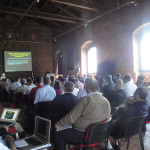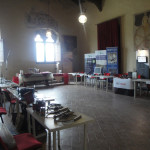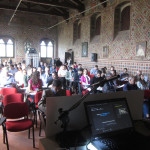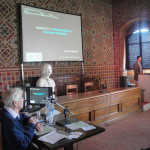Location
The course will be held inside the X Century
Castle of Poppi (Tuscany), considered one of the most beautiful castle in Italy.
Lectures will be done in the “Ballroom”, where, during the Middle Age the Counts Guidi held banquets,
parties, shows. The coffee break will be in the Courtyard, whose wall are decorated with many coats of arms.
The Castle of Poppi
The Castle of Counts Guidi is one of the most important examples of medieval architecture in the
province of Arezzo. The first documentary evidence of the existence of the castle of Poppi dates
back to 1191, but it is believed to have been built between the ninth and tenth century, after the collapse
of the Carolingian Empire.
The original nucleus of the castle consisted of the square tower that still dominates the rest of building and
almost all valley. Current appearance of the tower, however, is not the primitive one, in fact it was
transformed into a bell tower in the nineteenth century, during the restoration work following the damages
suffered after a lightning strike. The tower had to be much higher and equipped with a projecting brackets
apparatus, such as
"Palazzo Vecchio" in Florence, of
which the castle of Poppi seems to be a “prototype”. The authorship of the building is in fact uncertain: the
oldest part is in part attributed to Lapo di Cambio, while the more recent one, dating to the late thirteenth
century, would be his son’s, Arnolfo di Cambio, author of the "Palazzo Vecchio".
The castle is today, except for the tower, as its medieval aspect was; the care and the strength with which it
was built have allowed the excellent preservation of it.
Inside the castle it is the courtyard, whose walls are decorated with many coats of arms.
At the end of the courtyard is a stone table, known as the “table of justice.” Here justice was administered
and the judgments were issued. This table began working in mid ’400 when the court was established in
Poppi. From the courtyard it is possible to enter the room of the battle, where reproductions of medieval
battle instruments are stored, and the “stables of the Guidi”, a room today generally used for exhibitions.
At the first floor you can visit
the Ballroom (location course), where the Counts Guidi
held banquets, parties, shows. The room is richly decorated with depictions of the most important figures
of the family and other sacred and profane ones.
Poppi
Poppi certainly is
the most distinctive village and symbol of Casentino. Medieval center
that still keep intact its walls, Poppi is placed at the top of a hill and its Castle of the Counts of the Guidi
family dominates the village and a good part of the valley. The history of Poppi is closely linked to that of its
family, one of the largest families of central Italy of the Middle Ages, which made Poppi the political and
administrative capital of the Casentino (“Poppi, the capital of the Casentino valley” is written in the Giorgio
Vasari’s fresco in Palazzo Vecchio, Florence). Symbol of the village obviously is the Castle of the Counts
Guidi, that stands at the top of Poppi; not less interesting are the numerous churches of the village, first of
all, the one of San Fedele, which hosts a crucifix made by Giotto.
The village is still enclosed within the medieval walls, around which one can admire the beautiful view of
the Tuscan countryside.
Thanks to its architectural and landscape beauty well preserved, which give still the flavor of the typical
medieval Tuscan village,
Poppi was recently included in the Club of the “most beautiful villages in
Italy”.
Tuscany
Tuscany, land of more than 2000 years of history, inhabited by the mysterious Etruscans and the great
Roman civilization, can be certainly defined
the cradle of the Renaissance and the birth place of
famous artists, writers and scientists of the past which left a historical, artistic and literary heritage
unique in the world. That’s why this is one of the most favorite tourist destinations.
Both if you choose to enjoy the
cultural heritage or the beautiful landscapes, Tuscany is the ideal
place for an unforgettable holiday full of good food and good local wine. In Tuscany there are so many
interesting things to see and do that sometimes it is hard to decide from what to start.
Florence, Siena and Pisa are among the favorite destinations, but the list of “cities of art” in Tuscany is
much longer and includes Arezzo, Cortona, San Gimignano and Lucca, just to name a few.







.jpg)
__2.jpg)
__3.jpg)
__1.jpg)


